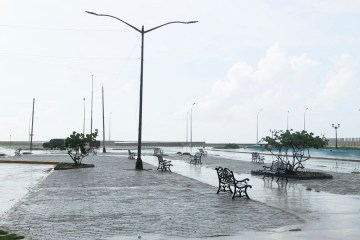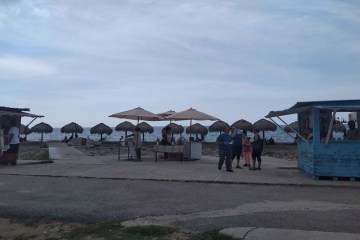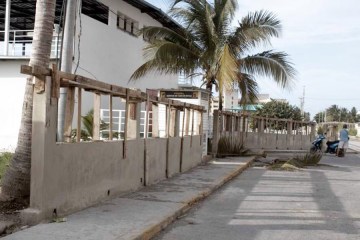Havana Building Projects that Cause Concern
Coming out of lockdown, city locals have been taken aback by works done during social distancing.

HAVANA TIMES – At a time when several Havana neighborhoods are going back into lockdown because of new outbreaks of COVID-19, residents in the capital are displaying an unusual interest and concern on their social media profiles about city building projects that took place during quarantine, between March and this month.
A new controversy, which has been limited to the virtual space of social media platform Facebook, was stirred at night on July 9th, because of renovation works on one of the Cuban capital’s main streets, G street.
Cobblestone flower beds
Cobblestones have been placed along the first stretch of the main avenue from the sea, in the avenue’s original flower beds, around benches with no shade.
Internet user Irene Martinez posted that this neighborhood was built “in the 19th century as the renaissance of a new way of life, far from the walled, dirty city that smelled bad, with narrow and sun-filled streets.”
She added that the urban design relied “on the harmonious inclusion of green spaces, which were divided down to the millimeter, with parks, flower beds, gardens and avenues” and “that 1m2 of green space per inhabitant was a requirement.”

Martinez’s comments posted with a photo, sparked rejection and people questioning this decision.
Even though this has only been done to a small stretch of the avenue (2 kms), that frequently suffers from coastal flooding, Yamile Salomon posted a question asking: “What sense does it make for them to do this? Who approves these things? Who was consulted about such a radical change that affects everyone?
While Jorge Luis Rekena believed that this is the result of “empowered ignorance and indifference,” Lili Delafe asked: “where are the advisory councils”, who should be giving the government technical recommendations when it comes to making decisions that are in line with the law.
Even though there were some voices mediating the ongoing discussion, most people were against it.
According to Alejandro Alonso, “there hasn’t been any vegetation there for years, because of sea surges. There is only dry land and two seagrape bushes.” Fabricio Gonzalez believed that “this park was a complete mess.”
Commenting on the post, Mercy Copa wrote: “that’s where the monument (of Independence general Calixto Garcia) stood, which was then taken to 5th avenue… and of course, as the sea makes it inland… well the easiest thing would be best, separate it and make a park or terrace, and then they would prevent having to recover vegetation after water comes inland…”
Comments left include one from Carlos A. Fleitas on his Facebook page; identifying himself an an architect, he said that in addition to green spaces, streetlights and benches were replaced that could have been restored and rescued.

“The green avenue has been replaced by a new, concrete one in a flash, when we should all be aware about the environment and, even more so, when it comes to respecting urban patrimony,” in Havana, he said.
Debora Vazquez brought another issue into the discussion, when she questioned the use of these building materials “when there are so many other things that need building in this country.”
Running into the same wall
This new online debate has been going on for a week, because of a wall that was raised along this seaside promenade on 1st and 70th streets, in Miramar, Playa municipality, and was then knocked down after protests on social media.
According to local press, an inadequate interpretation of Physical Planning about the Ministry of Science, Technology and Environment’s decision led to a perimeter wall being built on 1st and 70th streets, on a beach where a local development project has been running since last summer.
“Is it the result of a misunderstanding or lack of understanding, like the wall along 70th street?” Dania Quintana posted, comparing both incidents.

In the beginning, the project’s FB page explained that the wall was to stop children from accessing the road, which could cause accidents.
Complaints from locals on social media and in comment sections on digital media were linked to limiting public spaces and the alleged fee to enter a neighborhood beach on the reef, as well as how ugly the wall was.
A committee created by Havana authorities to assess the issue found that the wall didn’t meet requirements due to a poor understanding of Physical Planning’s ruling issued by the Ministry of Science, Technology and Environment, the highest authority of environmental policies in the country.
Within this context, the population also asked about the quantity of resources being wasted “at a time when the country can’t afford these luxuries.”
Likewise, they criticized the fact that there hadn’t been a discussion with the community about this building project and they expressed their wish “for decisions regarding public spaces that affect locals to be consulted before being implemented.”
One comment left on a local paper came from a reader identifying as Miguel, who asked “when they were going to publish the urban planning plan for the city that had been approved by the Council of Ministers and the urban planning plan for every municipality with regulations.”






With regard to the caption on the final photograph.
There is nothing unusual about Cuba’s beaches being all public, the same applies in other countries. What was peculiar in Cuba until some six years ago, was Cubans not being allowed to visit the better beaches reserved for tourists.
Specific small beaches were allocated for use by Cubans. A Castro form of apartheid.